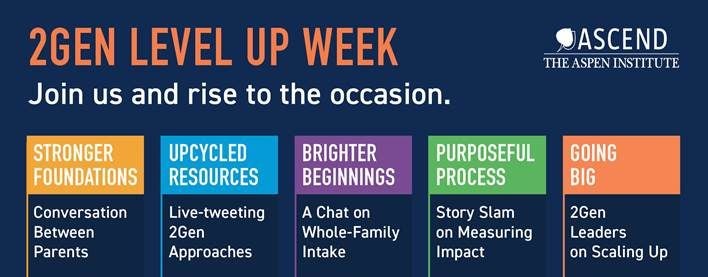WEBINAR: Telehealth and 2Gen: What are the Opportunities and Where are the Innovations
As the hub for breakthrough ideas and collaborations that move children and their parents toward educational success and economic security, Ascend is intensifying its efforts in the midst of the coronavirus pandemic to highlight 2Gen solutions that Ascend Fellows and the Ascend Network have developed over the past decade to help families reach their potential. Ascend is examining how new solutions, anchored in a 2Gen approach, can build and improve long-term outcomes that stabilize the health, economic well-being, and education of families as they recover and move forward from the COVID-19 crisis.
In a series of webinars, Ascend will tap the insights, expertise, and resources of the Ascend Network, Ascend Fellows, parents, and policy partners to offer solutions for how best to assist families now and ensure they have a stronger, more equitable future. Read on to learn about the TeleHealth and 2Gen webinar, and visit this page to learn more about the series.
In the midst of the coronavirus pandemic, TeleHealth has emerged as an essential resource for families. To explore the challenges and opportunities for TeleHealth practices and systems changes for children and parents, Ascend invited practitioners and parents to review the landscape of coverage for TeleHealth, discuss opportunities to expand and improve how families are served remotely in the coming months and years, elevate the experience of practitioners, and surface gaps in research that may need to be addressed to support the long-term viability of using TeleHealth services to meet the needs of families.
Speakers:
- Elisabeth Wright Burak, senior fellow, Georgetown University’s McCourt School of Public Policy’s Center for Children and Families (CCF), Washington, D.C.
- Joshua Sparrow, MD, executive director, Brazelton’s Touchpoints Center, Boston Children’s Hospital, Boston, Massachusetts
- Jazzy Green, parent, Parents as Teachers, Topeka, Kansas
- Daniel Huang, mental health counselor, Hamilton Madison House, New York, New York
- Jennifer Jonika, director of maternal and early childhood clinical services, Starfish Family Services, Detroit, Michigan
- Tista Ghosh, MD, Ascend Fellow, senior director of impact evaluation, Grand Rounds, Denver, Colorado
The webinar was moderated by Sarah Haight, associate director for network and outreach.
Watch the webinar recording here. Download the presentation here.
Telehealth Opportunities
Telemedicine uses technology to deliver medical care at a distance. Typically, a provider in one location uses a video setup to deliver care to a patient at another site, most often their homes. Although it is also delivered virtually, TeleHealth differs from telemedicine by providing a broader scope of remote, non-clinical health care services, including mental health care. Equally important during the crisis is the need for community organizations serving families and children to use TeleServices in place of home visits, which presents opportunities, but also imposes limits on assessment.
These virtual consults can support family well-being by offering parents the flexibility to schedule visits around their child’s sleep or school schedules and to accommodate their own work schedules. TeleHealth services also address factors that may cause patients to cancel an in-person visit, such as illness or transportation challenges.
As parent Jazzy Green explained, “We have cancelled visits before because [my daughter] was sick or I was sick, and I didn’t want to get the people in the [doctor’s] office sick. It would have been great if a virtual visit was an option, so we could stay on track and not have to catch up later.”
Since stay-at-home orders, school cancellations, and other measures designed to control the spread of COVID-19 began in March, health care providers throughout the country report an uptick in the number of patients seeking TeleHealth services. During this time, TeleHealth policies have rapidly evolved and continue to change on an almost daily basis.
At the federal level, a move toward loosening TeleHealth restrictions— including allowing practitioners to interact with patients using everyday communication technologies such as FaceTime or Skype without breaking HIPAA rules — has made it easier for many people to access care such as mental health and child development consults without leaving their homes. These changes are leading more people continue treatment during stay-at-home orders.
Temporary changes to Medicare coverage — including expanding the range of TeleHealth services covered, waiving the geographical site restrictions on Medicare TeleHealth services, and ensuring more people maintain coverage — are also enabling beneficiaries to access care for themselves and their families without having to visit the health care facility. (Learn more about changes to Medicaid and CHIP in response to COVID-19 here).
To date, 47 states and the District of Columbia have also taken action to remove policy barriers to accessing telehealth services, including enacting payment parity and relaxing licensure requirements, making it possible for patients to schedule remote visits with physicians licensed in another state or from retired or clinically inactive physicians.
Although these changes are set to expire once the current emergency passes, they are giving policymakers and practitioners an opportunity to explore the benefits of using TeleHealth services to ensure more people are able to access quality health care services.
Challenges to Address
Although the current medical crisis highlights a number of advantages to expanded TeleHealth services, it also offers policymakers and practitioners an opportunity to explore and potentially address challenges to virtual services.
Health care providers cite the lack of sufficient funding, particularly for pediatric care, as a major challenge to expanding TeleHealth services. The shift toward TeleHealth services requires different equipment, including more mobile units, as well as staff training and time to learn how to navigate new systems. These demands are eroding primary care infrastructure.
As physicians work to understand new TeleHealth reimbursement policies, many care providers — especially pediatricians — are reducing their fees or going without pay, which could reduce the pediatric care workforce.
Doctors also note referrals are declining while deferred or cancelled appointments are at an all-time high. People are not seeking care because they are worried about the coronavirus or because offices are closed. This is likely to lead to a flood of need when the current crisis passes. Financial instability — particularly for rural hospitals, which are reporting a lack of patients — may cause facilities to close indefinitely, leaving fewer resources to care for this pending need.
General practitioners report challenges to fully assessing a child without seeing them in person. Physicians providing TeleHealth services may be less likely to detect or address mental health challenges associated with isolation, child abuse, or other social determinants. Some parents may also be inclined to delay services that cannot be performed remotely, such as immunizations for diseases like mumps and measles, which could cause these diseases to spike once the pandemic is over.
Although it offers more flexibility to families, TeleHealth services may also foster increased health disparities, especially for individuals who do not own the equipment needed to access services, such as a tablet or laptop and reliable internet. Additionally, some patients may not participate in TeleHealth services because they are worried about privacy. This is particularly challenging for families who are currently confined to close quarters.
Privacy issues may also play a role in cultural barriers to accessing TeleHealth services. The stigma some people associate with mental health treatment makes it harder for them to access TeleHealth services if they do not have a private place to conduct the session.
What’s Needed Now
- Medicaid agencies are incredibly stretched as they work to ensure people are in the program. We need to support Medicaid agencies in effectively communicating coverage to families with low incomes, and capture the impact of more comprehensive coverage;
- We need more collaborative efforts to provide a portfolio of resources for agencies, practitioners, clinicians, and policymakers to trust leadership in providing clear guidance on the rapidly-changing waivers and laws;
- There should be updates to the CARES Act to fully fund TeleHealth support reimbursement to ensure the shift to TeleHealth maintains the revenue needed to support this infrastructure and workforce;
- Fee-for-service does not work – we need better funding mechanisms for crisis and major CMH overhaul;
- It is critical that public-private partnerships support research around TeleHealth and evidence-based practices and outcomes;
- Organizations need to look at access to TeleHealth services with an equity lens that addresses disparity issues, such as access to technology and privacy concerns;
- To meet the shortage and demand plus rural health access, we need to incentivize TeleHealth more and improve adoption.
Post webinar, speakers answered some of our listeners’ questions. Read their answers below.
What are ways that providers can encourage their hospital systems or employers to use their voice and advocacy resources to lift up health disparities?
Jennifer Jonika: Starfish has collected our county and state well-being stats (each state has a KIDS Count Data Book, census data, or published community needs assessments to use), as well as shared quotes and stories that have been approved by families for advocacy use. We put it all in a document, along with our funding issues, and have shared it with state advocates, state representatives, state departments that could make an impact, as well as agency partners and have asked them to share the document. In our county, we also developed a “provider collaborative” with high level executives so that we had one strong message across providers. The biggest lesson I have learned is that people respond to impact stories. You can also help clients use their voice by contacting their local state representatives.
Elisabeth Burak: Across all of these questions, I encourage participants to reach out to statewide advocacy groups that are familiar with state Medicaid policies. They would welcome ideas about how they can support kids and their families and the systems that serve them during this crisis and beyond from folks working directly with families, if not families themselves. They are also good partners on policy and political processes in the state, at both the legislative and agency policy levels, and can hopefully save you some time. Contact info for many groups like this can be found through the following links: Partnership for America’s Children and KIDS COUNT State Network.
Joshua Sparrow: Hospital systems can — and some do — track health access, output, and outcome data according to race and ethnicity. This data collection, analysis, and application should be designed and implemented with the leadership and authority of professionals who identify as belonging to racial and ethnic groups that experience healthcare access and health outcomes disparities. They should drive frequent reviews of this data and take a systems approach to collaborative problem-solving. The Institute for Healthcare Improvement’s Breakthrough Series might be of use for this work. If also driven by professionals of color, insurers could analyze outcomes data to indicate whether additional services should be covered to improve equitable health outcomes.
Do you think TeleHealth should “stick” as an option (though not requirement) for families with low incomes if/when a vaccine becomes available? Why or why not?
Jennifer Jonika: Yes! I would like to see if it decreases cancellations and “no shows.” Oftentimes, our families cancel appointments due to transportation, someone in the home being sick, or something in the environment happening (safety issues in the home or neighborhood). For children’s mental health services, I don’t think TeleHealth should be considered best practice because proximity to families is so important. But I think it should be used in the future as an option to cancel appointments.
Elisabeth Burak: Yes, I think TeleHealth expansion can be useful to rethink how families access services and where, when appropriate. Some of the things that have loosened up in the face of the emergency (e.g. privacy protections enforcement) may need to be adjusted/revisited as we work to keep some of those gains, but that’s why this is an important learning period to capture what services should always be essential for families, regardless of emergency.
Joshua Sparrow: TeleHealth should be an option for all families, in part to avoid unintended consequences of labeling TeleHealth as primarily for families with low incomes. Telehealth has benefits such as increasing access for individuals and families living in remote, rural communities, particularly access to mental health and other specialty providers. It also reduces transportation and time barriers. It also has many drawbacks, including lack of access for individuals and families without devices and/or broad band connections. It cannot replace in-office visits for vaccinations, physical examinations, and other assessments that require physical presence and interaction. Another drawback is that some families may find it intrusive. Yet for those families who are comfortable with it, TeleHealth can provide useful insights into the home environment.
Using TeleHealth in early childhood — where are the resources? Any recommendations on how to use the current policy information on Medicaid waivers in states that are not offering much flexibility?
Elisabeth Burak: There is potential for Medicaid to pay for early childhood health interventions if they aren’t already. Many states pay for early intervention or mental health services in 2gen ways, but it’s not universal (see here and here for more information). They can benefit from TeleHealth as well, if a state’s Medicaid program has chosen to support in that way. When looking to policy or payment changes in Medicaid, you first need to know the state-specific landscape to see where the policy holes are. Each state is different in terms of what is necessary for change. You may want to partner up with advocates or provider associations who know your state Medicaid policy/agency world well to help them understand family and practice challenges and work together to lay out where policies may be a barrier, as opposed to implementation or oversight. Depending on what your state had in place before COVID for TeleHealth, policy changes to expand may not have needed a waiver or other federal approvals (e.g. state plan amendment). If your state used an emergency waiver or SPA to do more (allow additional providers to do TeleHealth, in additional settings, additional platforms, all of which likely are reflected on your state’s Medicaid website), it’s a good time to learn what is working and what isn’t for families and practitioners to make necessary adjustments in long-term policies.
How are you thinking about PTSD and treatment strategies for the next few years, beyond the immediate crisis of the pandemic?
Jennifer Jonika: I think the variety of evidence-based treatment approaches doesn’t need to change, but clearly there will be a much higher need for clinicians trained in an evidence-based practice (EBP) for PTSD. Other professionals may also need to be better trained in screening for PTSD and other mental health problems that come from this crisis. One of the major issues my team of clinicians struggled with is how to do interventions over TeleHealth and we had to remind them that while the modality has changed, the interventions and what they know and how they are has not changed. One of the prevention strategies we have implemented for trauma and/or toxic stress in our preschool classrooms has been the use of a program out of Kansas City called “Trauma Smart” and co-locating one of my IECMH staff in each of our classrooms to support children with big emotions and big behaviors. I can see that being a future benefit to childcare providers and schools when children come back to school.
Daniel Huang: A trauma-informed approach to treatment is always important, and perhaps even more important after the widely felt trauma of this pandemic.
How are you handling HIPAA compliance and zoom – is that changing with privacy concerns with zoom?
Jennifer Jonika: We have a document from our state that references updates to HIPAA compliance to allow for easier access to families. Our agency is using a professional (paid) Zoom account for any provider discussions regarding clients because I believe the issue was the free Zoom accounts. For direct TeleHealth services, we purchased a Doxy.me account that seems very user friendly and I believe it’s a per staff per month fee. I do know private clinicians who are using any form of communication they can and documenting attempts to protect client information, as well as full informed consent of the client for whatever they are using. We implemented a policy of documenting consent each time a TeleHealth session happens.
Daniel Huang: We have chosen to use a TeleHealth platform that allows us to be HIPAA compliant — Doxy.me.
How has home visiting shifted your perspective on what is possible for you?
Jazzy Green: Home visits has shown me that Parents as Teachers (PAT) really works, I really can make toys out of household items all on my own. Usually, Ms. Nichole brings the supplies along with her but now I find myself saving old Parmesan cheese containers and seasoning containers because Marleigh can use these as toys and help to develop her fine motor skills. Really you can do this with anything, we’ve made sensory boxes with flour, play-dough with ingredients I had in the cabinets and sorting toys with the Parmesan container all thanks to PAT and the virtual services has shown me I really do have this stuff at home and it’s at no cost to me. So, we’ve gotten very creative in our time at home!
Additional Resources
Coronavirus (COVID-19) Resource Center
Families First Coronavirus Response Act Freezes Disenrollment in Medicaid
How Would Families First Coronavirus Response Act Protect People and Public Health
Related Posts















